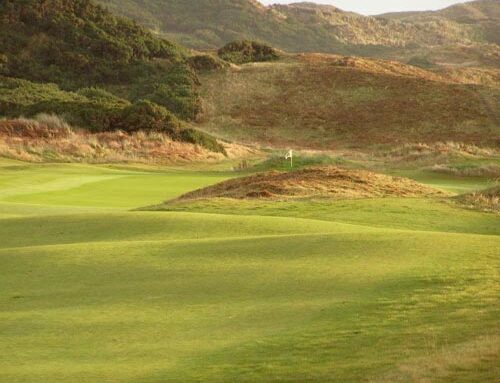Royal Portrush Golf Club (Dunluce Links)
Northern Ireland
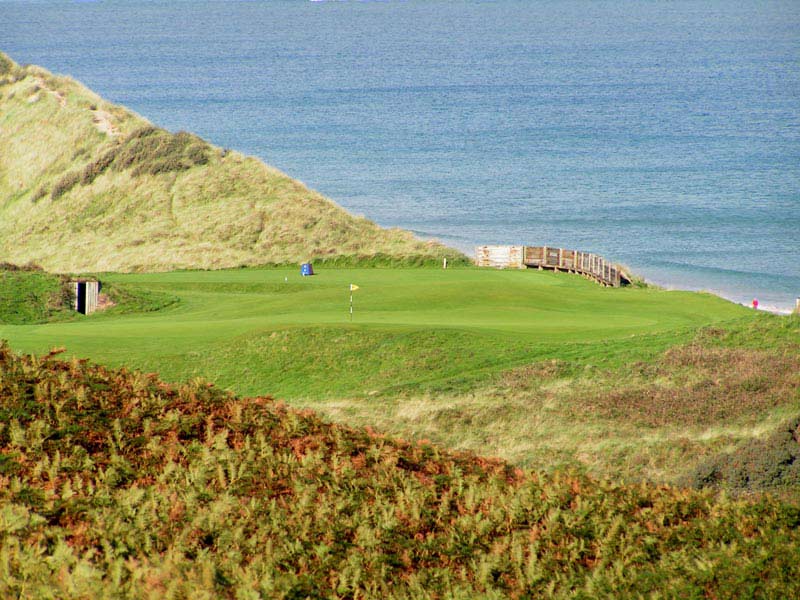
Rounding the bend as one approaches Portrush from the east, one of the game’s most glorious sights unfolds: the 5th green along the cliffside.
Forget Magnolia Drive or Seventeen Mile Drive. Never mind the dirt road at Yeaman’s Hall. The best entrance to any golf club is the A1 as it snakes along the cliffs along the rugged northern Antrim Coast of Northern Ireland. Rounding the bend, Royal Portrush Golf Club unfolds before one’s eyes, set among tumbling dunes that run to the cliff’s edge with the Atlantic Ocean pounding below. The 5th hole’s flag flapping in the wind is as inspiring a sight as a golfer will ever find. The game is about to commence! As good as the land is, the lasting merit of the course derives from the work carried out by Harry S. Colt in 1932. Prior to that, Royal Portrush Golf Club enjoyed play over 18 holes designed by Old Tom Morris in 1890 on property slightly south and west of the land given to Harry Colt. Harry Colt is generally associated with heathland designs. Starting with his days as Secretary at Sunningdale, he understood heath courses like no other. Swinley Forest, Sunningdale (New) and St. George’s Hill bear testimony to his genius in working on a heath. However, like any great architect, he got the most out of any type site. His work with parkland courses around Toronto, Canada is an example. And with the links land at Portrush, he was given his most rugged property for an original 18 hole layout and the result is his sternest test.
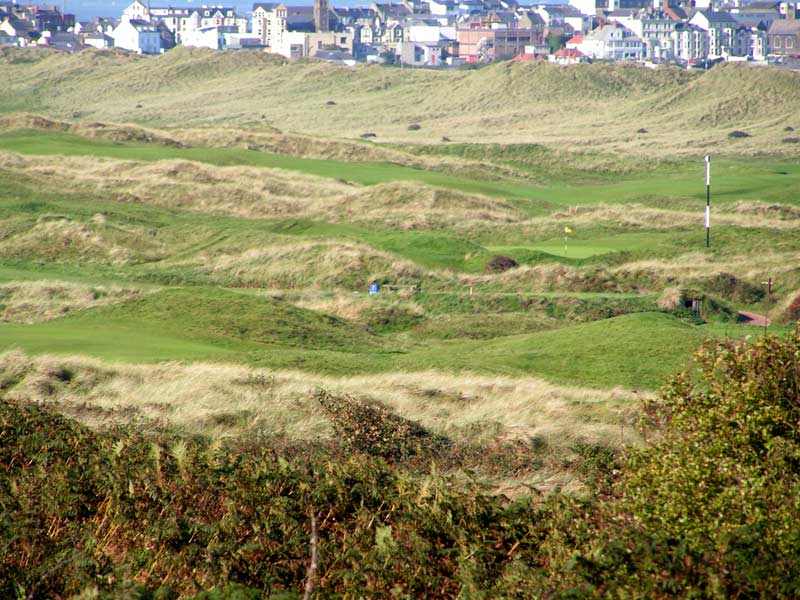
Portrush’s crumpled dunescape provides the ideal setting for links golf of the highest order.
Thepropertyconsists of parallel sets of dunes. Little fairway bunkering was called for; rather the curvature of the fairways between the dunes places a premium on accuracy off the tee. From the 2nd through to the 16th hole, all the two and three shot holes bend one way or another.
Unlike its nearby neighbor, Portstewart Golf Club, the course stays in the dunesland until the final two holes. The golfer appreciates just how good the land is, not only by virtue of the string of good holes he has just played, but also by how little affection the 17th and 18th hole seem to command (and the 18th is a solid hole!). Sloppy or indifferent shots that are acceptable on other links are not tolerated. Off the tee, the ball plunges into the thick grasses that sweep over these dunes. A tough examination? Absolutely, without question and the skilled golfer relishes the opportunity to not only control the flight of his ball but also shape it either way off the tee depending on the requirements of the hole and the day’s wind. Up ahead, one of the best conceived green complexes in the United Kingdom await. Coupled with the pressure the grass covered dunes place on tee shots, Harry Colt‘s superb green complexes make Royal Portrush the complete examination. For many an accomplished and well traveled golfer, the setting and the challenge makes the Dunluce Golf Course at Portrush course among his favorite dozen or so courses in the world. However, what about the handicap golfer that makes up the majority of the game? Unfortunately, too much time is now being spent with one’s head down beating the thick, meadow grass in hopes of uncovering one’s ball. Located on the Emerald Isle, Ireland/Northern Ireland experiences greater annual rainfall that England. Thus, the natural state of the dunesland grasses is to be more plush than that found in England. Such is fine but the rub at Royal Portrush is that some of the corridors between the lines of the dunes are relatively narrow. The opportunity to enjoy the width found at other world class courses located in similarly windy spots like Ballyneal (with fairways up to 100 yards in width) and National Golf Links of America (with fairways up to 70 yards in width) simply isn’t present. Given its topography, a windy day at Royal Portrush can see the 10 handicap golfer lose many a golf ball. This is a shame as the essence of golf is to find one’s ball and play it, ideally all the way through the round. The chance for miraculous recoveries are few and far between on The Dunluce Golf Course at Portrush Links. The black and white photographs from several decades ago in the upstairs of the Royal Portrush clubhouse show the dunes with far less vegetation. A series of dry summers might help. Of course, having hosted the only Open Championship outside of England and Scotland, the Club might well enjoy fostering its reputation for being tough. Regardless of the penal nature of its grasses, the design features that Harry Colt provided here are among the best in golf architecture, as we see below.
Holes to Note
First hole, 390 yards; In many ways, this hole summarizes Royal Portrush: very well designedbut with current maintenance practices undermining some of Harry Colt‘s strategic merit. Presently, out of bounds is on both sides of the fairway with rough growing in from the rightout of bounds. In Harry Colt‘s day, the fairway was broader than its present 35 pacesand the golfer was free/encouraged to approach the green more from the right to avoid the terrifyingly deep gathering front left bunker. The genius of Harry Colt‘s design was in an equally deep left bunker (though out of sight) that once ate up shots that came in too ‘hot’ from the right.Unfortunately, the angles of playare presently reduced due to the narrowing of the fairway, rendering the clever hidden left bunker less of a factor. Harry Colt deserves plenty of credit for this well conceived hole and with more short grass, this hole would be all the better/more interesting.
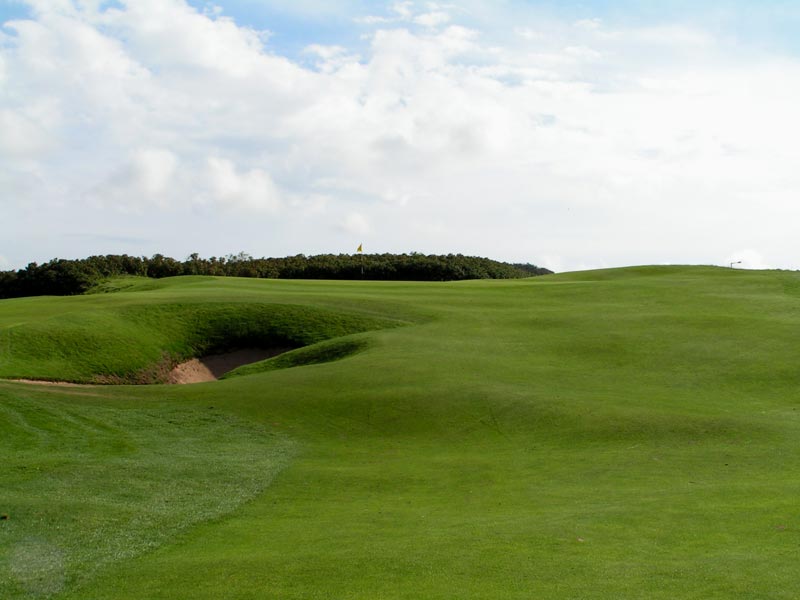
The large gathering bunker at the 1st sucks in golf balls from well away. Indeed the author was pleased to see his opponent putt into it.
Second hole, 505 yards; Though the present clubhouse is only a decade old, it has been in the same general position since Harry Colt‘s day. One can imagine Harry Colt finding the first hole to the naturally raised green and then his delight in seeing the playing corridors emerge along the high portion of the property all the way out to the 5th tee. The bending nature of 2nd fairway is a characteristic that makes Royal Portrush unique among most links and that is the high number of dogleg holes. The 2nd joins the 5th, 7th, 8th, 9th, 10th, and 16th holes as swinging markedly. In this case, the 2nd plays through a natural valley with three bunkers 60 yards short of the green. The good player is keen to carry to them in pursuit of a good score, especially appreciating how the difficulty of the course grows and grows from here on.
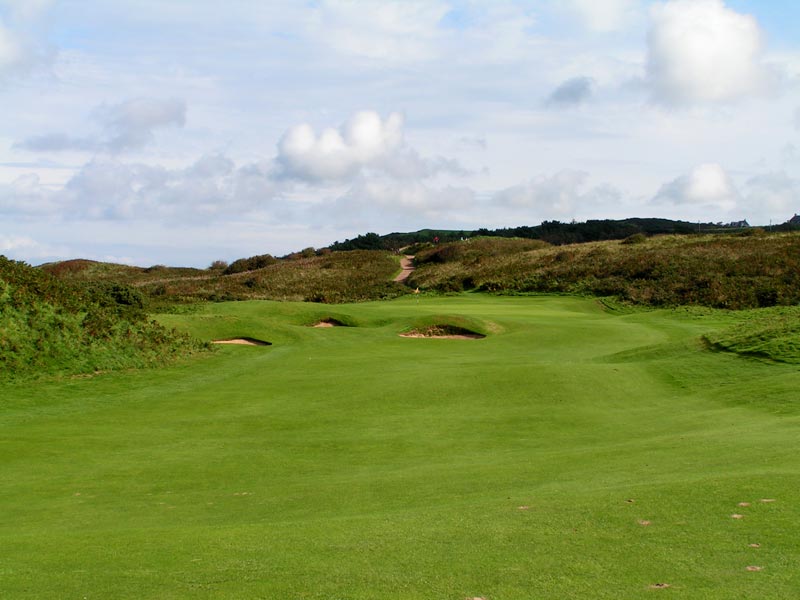
Played through a natural valley, the key to the 2nd is whether the golfer can get past the bunkers sixty yards shy of the green in two shots.
Third hole, 160 yards; The shortest hole on the course features a tee and a green on a knob at the highest points on the course. Themerit of locating such a length hole on one ofthe most exposed areas of the course becomes apparent on a windy day. With no place to hide, the golfer needs to control the flight of his ball and to hit the shot requiredby the day’s wind. Downwind, the hole is but a pitch. On other occasions, the hole can be a drawn 3 iron, as the author’s brother fondly recountsfrom a cold April day in 1985.

Downwind, as pictured on this day, the front right hole location is the toughest to get close to due to Colt’s front right slope.
Forth hole, 440 yards; One of the best unknown holes in the world, the hole is characterized by out of bounds down the right, deep central bunkers and a green tucked in dunes.
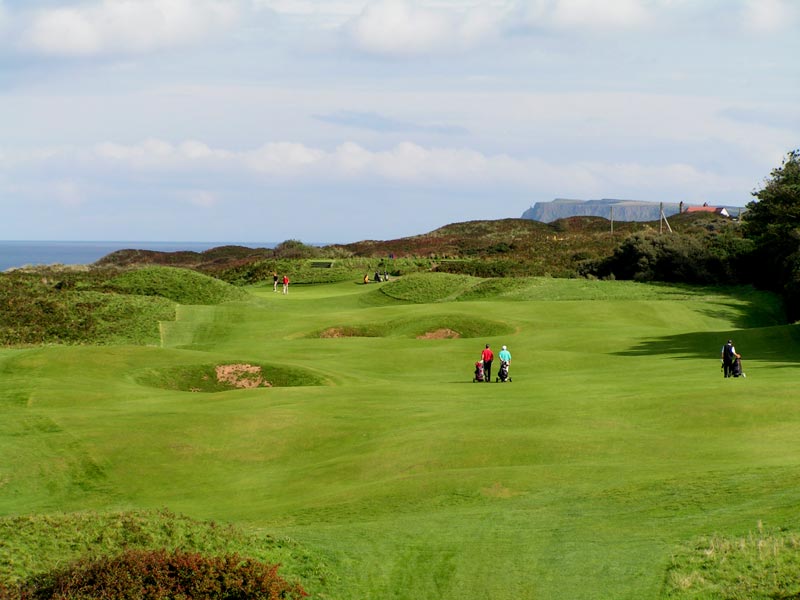
With out of bounds down the right and thick rough left, the deep central bunkers in the 4th fairway become all the more prominent.

Tucked into the dunes, Colt’s construction of the 4th green is further proof of why he is considered one of the finest golf course architects of all time.
Fifth hole, 385 yards; One of the world’s handful of most inspiring holes, some consider it the quintessential dogleg as the line off the tee for the tiger golfer and the dub may be as far apart as 100 yards. The strong player shortens the dogleg to the right by taking an aggressive line with his driver, sometimes nearly on a direct linewith the front edge of green. The green itself runs to the cliff’s edge, making back hole locations a real test of courage. As with some of the other doglegs including the 8th and 16th, the golfer is better served by playing to the outside of the dogleg. In this case, a quirky butwonderful mound obscures the view of the putting surface from the right side of the fairway. A step in the green effectively makes this a double plateau putting surface.All these features conspire to make itone of thetwo or three greatest bunkerless holes in the game, joining Foxy at Royal Dornoch Golf Club and the 13th at Paraparauma Beach in New Zealand.
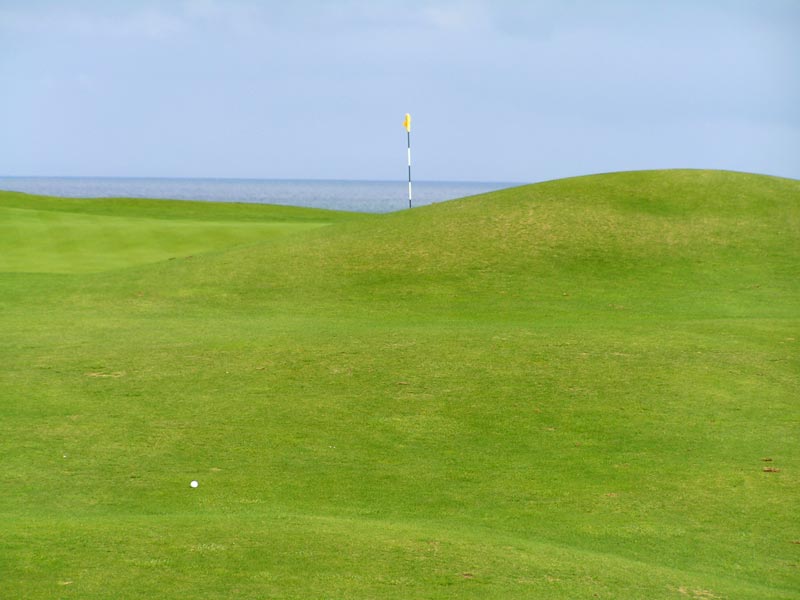
The large knob shy of the 5th green obscures views of the putting surface from the right portion of the fairway. This tee ball finished in the left half of the fairway and the day’s hole location is still partially hidden.
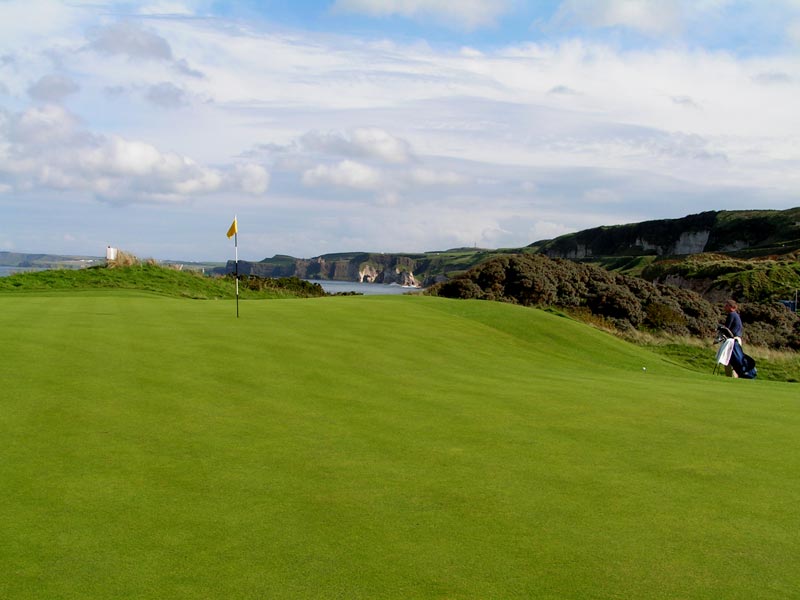
Given its stunning setting, few golfers concentrate on their golf. However, particular attention needs to be given to the two foot rise in the green. The ball in the photograph above was once within five feet of the hole; now the golfer is delighted to get down in two.
Royal Portrush Golf Club (Dunluce Links)
Northern Ireland
Sixth hole, 190 yards; The design of this hole may well be the equal of the more famous 14th hole. It is fittingly named Harry Colt’s, a tribute to perhaps the master of all time in building great sets of one shot holes. Colt leveled off a dune top and the green site on a plateau makes the hole an exacting shot with thegreen complex shunting aside the indifferently hit ball. A fade is ideal, as the green angles away to the right. Once again, no bunkers were required, so good is the land. The green is two tiered and along with the 8th, is the longest on the course. Getting at a back hole location is the single most demanding approach shot at Portrush. Unfortunately, the thick nature of the rough (which can result in a lost ball) means that anyone chasing after such a hole location is either supremely confident or foolish indeed.
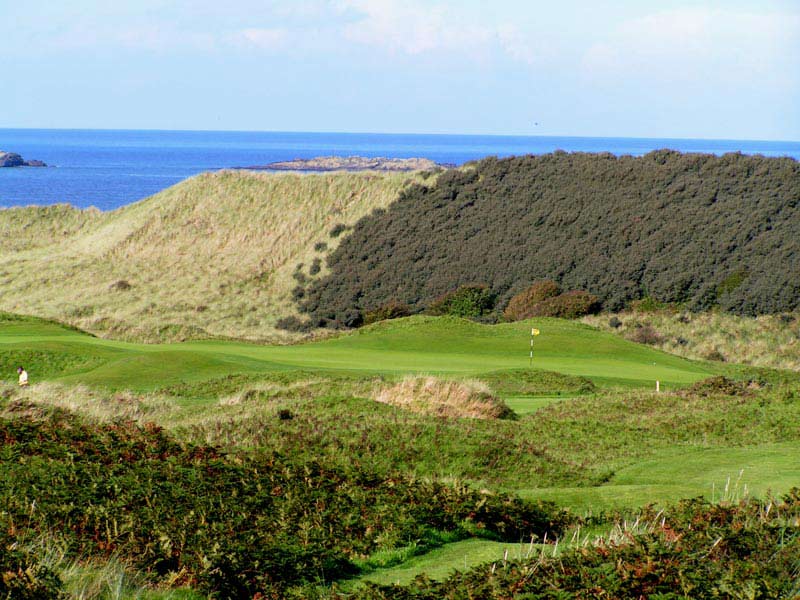
This view from well left of the hole shows the 45 yard long 6th green as it rises to a back plateau.
Eighth hole, 375 yards; This dogleg swings to the right but the golferneeds toavoid the temptation to shorten the hole too much as the corridor between the dunes narrows 90 yards from the green. A well played three wood leaves the golfer on a plateau with a level stance looking down the length of a long slender green perfectly nestled between dunes. With a green that is 45 paces deep, the key to this modest length hole is in controlling one’s short-ish approach, never but so easy with a ‘breeze’ about.
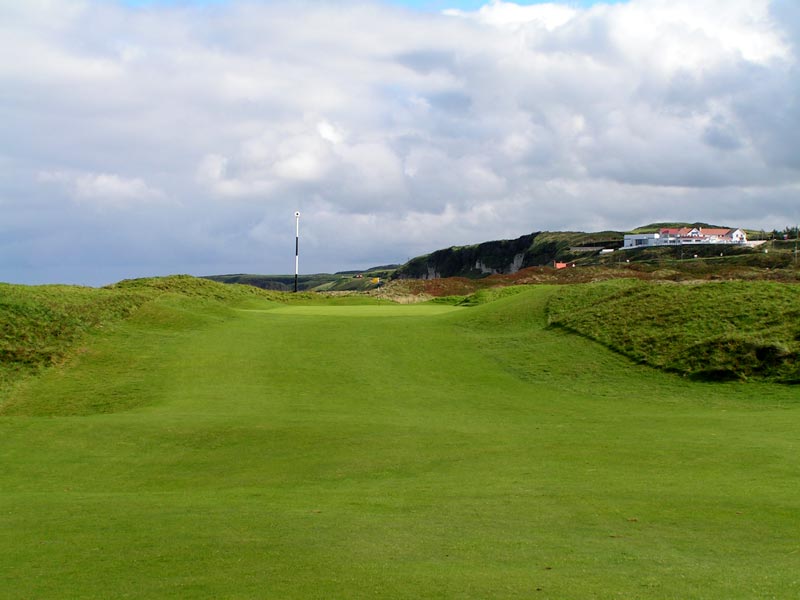
The way Colt found/created green sites on top or in dunes separates Portrush in quality from all most all other links.
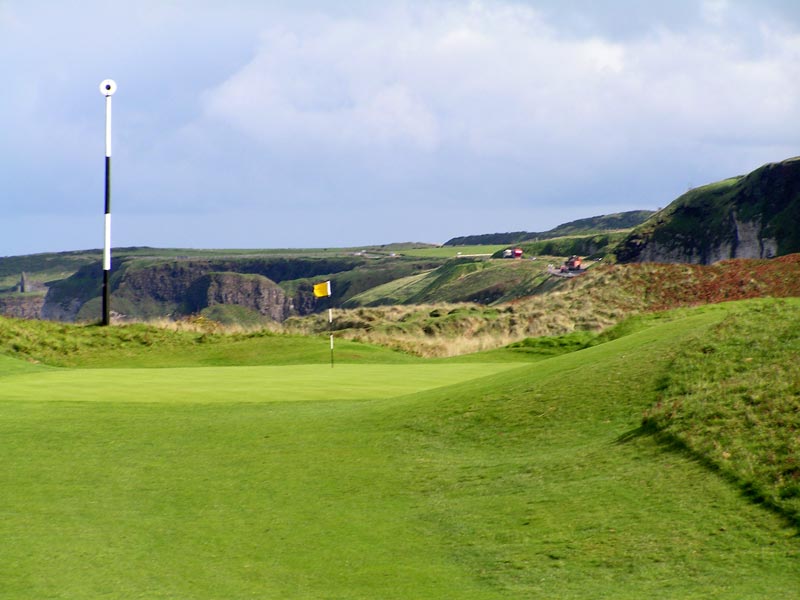
Closer up at the 8th, the day’s hole location is actually 37 paces onto the green, requiring at least one additional club for one’s approach.
Twelfth hole, 390 yards; A much respected links hole, thanks entirely to its green complex which falls away on all sides. A hidden twelve foot deep bunker long left is to be avoided at all costs. Once aware of its presence, most golfers shy well away and end up chipping onto the green from elsewhere, having to contend with the closely mown banks that ring the built-up green. Though simple in appearance, the 12th is full of both great golfing quality and terror.
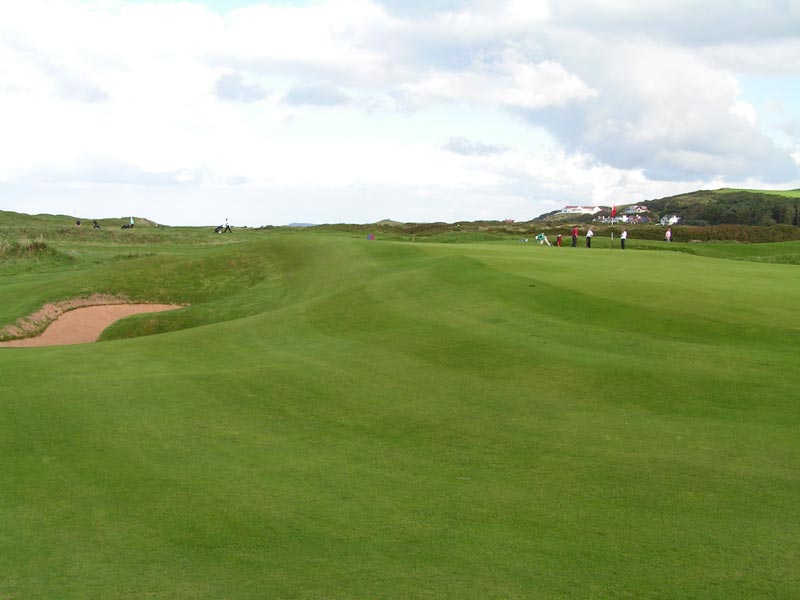
As seen from the front left, the 12th green seems simple enough, right until one’s ball is gathered into the pit bunker left of the green.
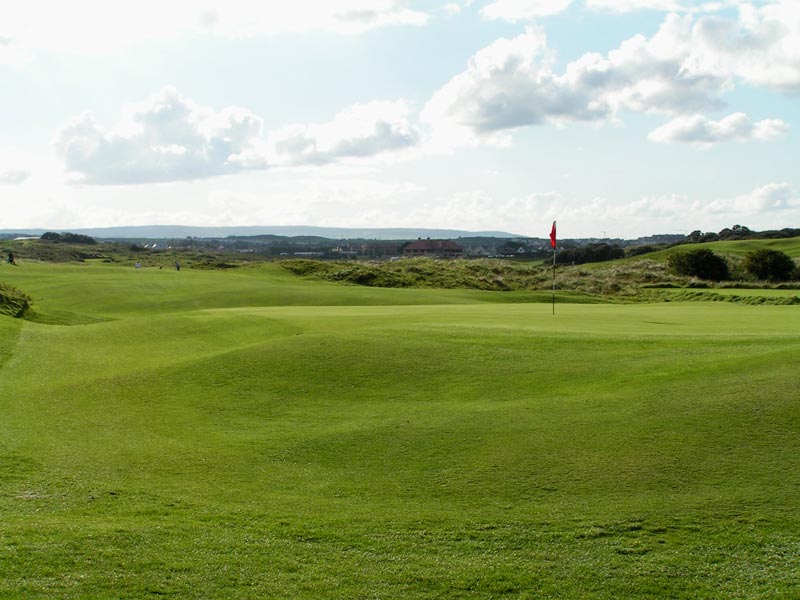
Once the golfer experiences (or sees his playing partners grapple with) the left bunker at 12, an amazing number of subsequent approach shots are steered right. This view from long right of the green shows the subtle terror of short grass.
Thirteenth holes, 370 yards; A superbly routed hole as it attacks the dune in a manner like no other hole at Portrush, which is to say that it goes up and over the dune. A successful drive to the crest leaves the golfer with an enticing approach toward the Skerries Island in the distance. Much to Colt’s credit, he takes the golfer to the cliff line in the middle of each nine. Manyhold his two looping nines at Portrush as being among the ideal routings in the game.

The view from the 13th tee where golfers have played fine drives to the crest of the hill.
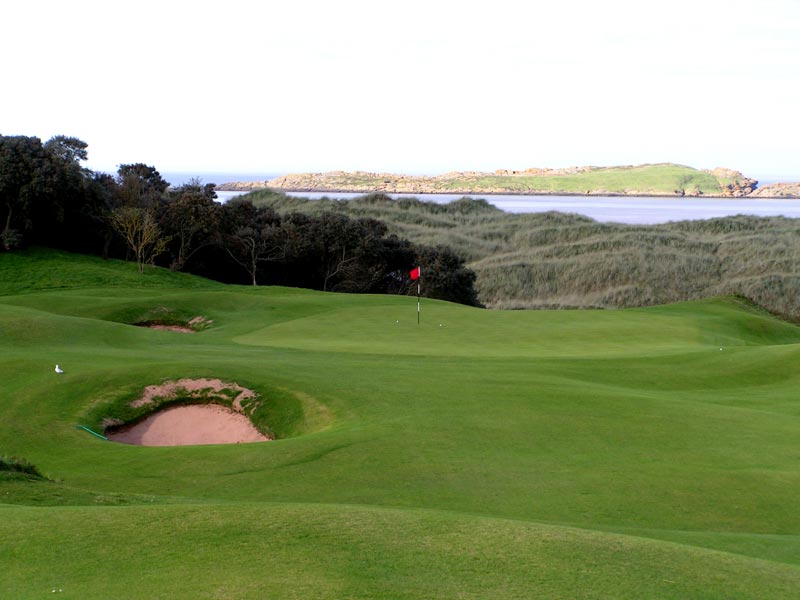
Once over the crest, the golfer is greeted with this thrilling approach.
Fourteenth hole, 205 yards; As prepared as one may be, the first encounter with Calamity rarely is successful. The 60 foot gully/ravine to the right, the wind and the sound of the pounding surf make the bail out area to the left of the green appealing. However, Colt insured that if you miss one of these medium size greens that an up and down would take some considerable doing.

These golfers watch the flight of the ball from the 14th tee. The not-to-be missed Valley Links at Portrush occupies the ground below.
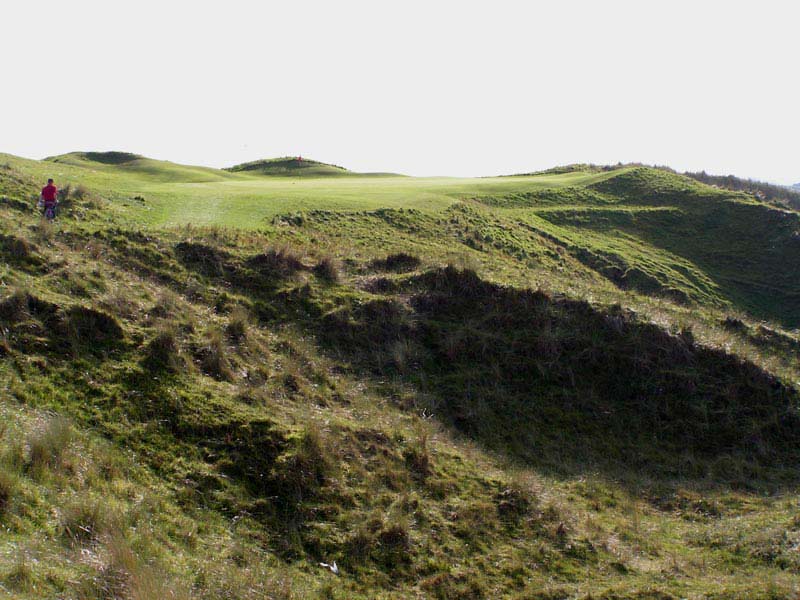
A view from the tee of the well named Calamity Hole. Always on the lookout for locations for one shot holes, Colt would have found this hole early on as he wrestled with the routing for the course.
Colt must have been thrilled upon first site of the rim of the crater at the 14th as it leant itself to the creation of such a unique and world class hole. However, Colt was boxed in at this point and the 15th plays awkwardly out of the dunes.  The remaining three holes are over other the least inspiring property of the course. However, like everygood architect must, Colt made the most of the opportunities, primarily through his more extensive use of bunkers. The 16th is a fine dogleg two shotter, thanks to the bunkered rise in the ground eighty yards short of the green and the tightly mown fall off left of the green. And the 18th with its eleven bunkers has been converted into a strong 455 yard two shotter from an indifferent par five of some 30 yards longer. In 1997, Gary Player whistled in a three wood to set up the deciding birdie and victory in the Senior British Open Championship. The sense of occasion that this Home hole now provides makes it a much more satisfying conclusion than it is generally given credit for being. With minimal natural features with which to work, Colt’s eleven bunkers (nearly 20% of the bunkers on the entire course!)give the Home hole its interest. As The Troubles subsided in the 1980s, Royal Portrush began receiving its due recognition. As an examination in driving and approach shots, placing ones tee ball consistently between the grass covered dunes is one of the most satisfying experiences a good golfer will find. Weaker golfers may tire of hunting for golf balls and should give consideration to playing the other course at Portrush, The Valley Links. In particular, stretch of holes from the 7th to 10th on The Valley Links is the equal of any of the non-cliffside holeson the Dunluce course. Either way, a day at Portrush will linger with the golfer for a long time indeed.
The remaining three holes are over other the least inspiring property of the course. However, like everygood architect must, Colt made the most of the opportunities, primarily through his more extensive use of bunkers. The 16th is a fine dogleg two shotter, thanks to the bunkered rise in the ground eighty yards short of the green and the tightly mown fall off left of the green. And the 18th with its eleven bunkers has been converted into a strong 455 yard two shotter from an indifferent par five of some 30 yards longer. In 1997, Gary Player whistled in a three wood to set up the deciding birdie and victory in the Senior British Open Championship. The sense of occasion that this Home hole now provides makes it a much more satisfying conclusion than it is generally given credit for being. With minimal natural features with which to work, Colt’s eleven bunkers (nearly 20% of the bunkers on the entire course!)give the Home hole its interest. As The Troubles subsided in the 1980s, Royal Portrush began receiving its due recognition. As an examination in driving and approach shots, placing ones tee ball consistently between the grass covered dunes is one of the most satisfying experiences a good golfer will find. Weaker golfers may tire of hunting for golf balls and should give consideration to playing the other course at Portrush, The Valley Links. In particular, stretch of holes from the 7th to 10th on The Valley Links is the equal of any of the non-cliffside holeson the Dunluce course. Either way, a day at Portrush will linger with the golfer for a long time indeed.
The End



